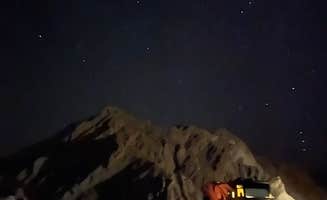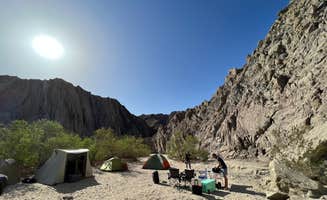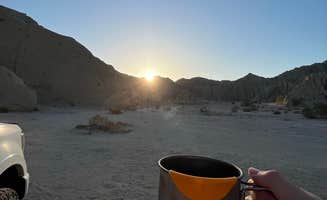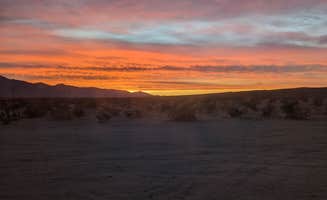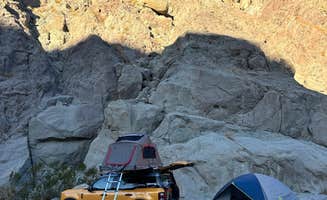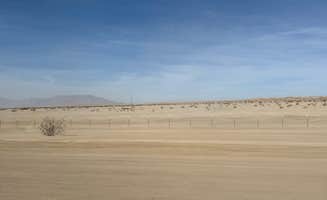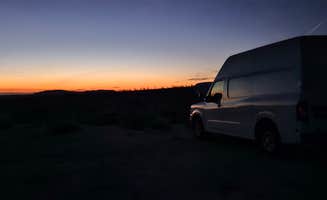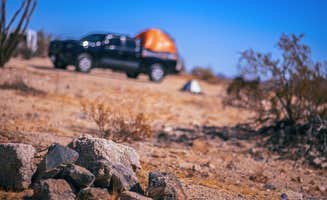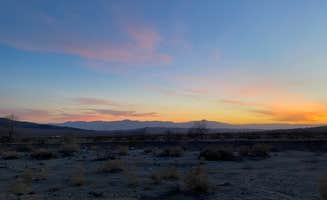Free camping near Coolidge Springs, California sits within the Colorado Desert region at elevations between 200-1,500 feet. The area receives less than 6 inches of annual rainfall and features rugged geology including slot canyons, sandstone formations, and occasional oases. Temperature swings can exceed 40 degrees between day and night during winter camping season.
What to do
Slot canyon exploration: Painted Canyon offers access to distinctive hiking routes with unique features. "There are marked trails and pit toilets halfway through the main road to the turnaround point," notes a camper at Painted Canyon. The area connects to Ladder Canyon which includes "a cool trail system with ropes and ladders at the end of the road."
Wildlife watching: Early mornings provide opportunities for desert wildlife sightings around campsites. "Hummingbirds came right up to my face! Didn't even know they lived out here. Also saw whiptail lizard," reports a visitor at Painted Canyon. At Blair Valley Primitive Campground, campers mention "lots of birds" in the rock gardens among various cacti species.
Cultural history exploration: Several sites offer access to indigenous cultural sites. "In the surrounding rock formations you may find morteros and metates used to process piñon, chia, and acorns that served in making dietary staples," explains a camper about Blair Valley. The area includes hiking trails to pictograph locations created by Kumeyaay people who inhabited the region for thousands of years.
What campers like
Dark sky viewing: The region offers exceptional astronomical viewing opportunities with minimal light pollution. A Blair Valley camper reports, "We were able to see so many stars and constellations. We saw shooting stars nearly every minute and we were also able to find Mars, Jupiter, Saturn, Uranus, and Neptune all with the naked eye!" The Borrego Springs area maintains dark sky community designation.
Site spacing: Joshua Tree South Dispersed Camping provides ample separation between sites. "Each site is pretty large and can fit at least 3 vans but they're only about 100 ft off the dirt road," notes one camper. Another visitor to Box Canyon Dispersed appreciates how "the area is pretty quiet but can be extremely hot in the summer so I wouldn't recommend it other than winter."
Rock formations: The geological features surrounding many sites create distinctive camping backdrops. At Blair Valley, one camper found "the perfect spot tucked up against the rocks. I had my own private rock garden with so many variety of cacti and lots of birds." These formations provide natural privacy barriers between camping areas throughout the region.
What you should know
Sand conditions: Many access roads require careful navigation due to variable sand depths. A camper at Mecca Hills Wilderness warns, "If plan to go decently far in or off the trail at all, make sure to have a 4x4 or traction boards at least. Got my camper van stuck here and even the tow truck almost got stuck." Avoid driving off established tracks without appropriate vehicles.
Temperature management: Extreme temperature variations require specific preparation. "Temps averaged 70-75 during the day and dropped to 38-42 at night but with a small fire and proper gear, we were plenty comfortable," notes a Blair Valley visitor during winter. Summer daytime temperatures frequently exceed 110°F making winter through early spring the primary camping season.
Outdoor bathroom considerations: Limited facilities exist throughout the region. A Joshua Tree South camper mentions the dispersed nature means "not a ton of privacy for outdoor bathroom usage, but not crowded enough for it to matter." Most areas have no facilities beyond occasional pit toilets at main access points or trailheads.
Tips for camping with families
Cactus awareness: Desert vegetation requires special attention with children. A Blair Valley camper advises, "Watch out for cactus and needles that are buried in the sand. It is not recommended to bring dogs or walk barefoot for this reason. Our sandals and boots both had many needles stuck in the rubber soles after the trip."
Site selection for wind protection: Wind exposure varies significantly by location. At Truckhaven, a visitor notes that "in some weather conditions the wind can be a bit much." Another camper recommends seeking sites "tucked up against" rock formations which provide natural windbreaks for tents and cooking areas.
Established areas for easier access: For families with younger children, consider sites with more established access. At Joshua Tree BLM by entrance, "There are fire pits and great access to the National Park," making day trips more manageable. The area offers "great cell signal and a lot of established sites with rock fire rings."
Tips from RVers
Road condition assessment: Verify current road status before attempting access with larger vehicles. A visitor to Blair Valley notes, "The road is a bit narrow but well maintained and there were plenty of trailers out there. Probably wouldn't take anything too too big." Most dispersed camping areas include sections suitable for RVs near main access points.
Surface firmness: Sandy sections can cause problems for heavier vehicles. At Joshua Tree South Dispersed Camping, one RVer reports, "The roads and sites (at least where we drove and camped) are not powder sand. Nope, more like small gravel. There were a lot of 5-wheels in there and we didn't sink in at all."
Proximity to facilities: Most sites lack hookups but some provide nearby services. "With a national parks pass, you can drive into the National Park about 5 miles to fill your water and dump your tanks," notes an RVer at Joshua Tree South Dispersed Camping. Many areas allow camping within 30-45 minutes of towns with basic services.


